ISSN ONLINE(2319-8753)PRINT(2347-6710)
ISSN ONLINE(2319-8753)PRINT(2347-6710)
Trupti Ingale1, A.A.Trikolikar2, Gunjan Rathore3, P.C.Latane4
|
| Related article at Pubmed, Scholar Google |
Visit for more related articles at International Journal of Innovative Research in Science, Engineering and Technology
In this paper we design and simulate a rectangular microstrip patch antenna operating at a frequency of 2.34 GHz. The rising importance of wireless communication and multimedia services increasing the efforts to the design and implementation of microstrip patch structures. A patch antenna is advantageous because of its low cost, small size, ease of fabrication, and can easily be integrated into many commercial transceiver systems. The performance of antenna is studied in terms of parameter like, Gain, Reflection Coefficient, VSWR, Impedance & Bandwidth of antenna.
Keywords |
| Microstrip Patch Antenna, Gain of antenna, Reflection Coefficient of antenna, VSWR of antenna |
INTRODUCTION |
| Microstrip antenna elements radiate efficiently as devices on microstrip printed circuit boards. Microstrip patch antenna consists of a radiating patch on one side of a dielectric substrate with a continuous metal layer bonded to the opposite side of the substrate which forms a ground plane. The patch is generally made of conducting material such as copper or gold and can take any possible shape. A patch antenna is a narrowband, wide-beam antenna fabricated by photo etching the antenna element pattern in metal trace on the dielectric substrate [1]. The structure of Rectangular Microstrip Patch Antenna (RMSA) is as shown in fig.1. For a rectangular patch, the length L of the patch is usually 0.3333λo < L < 0.5 λo, where λo is the free-space wavelength. The patch is selected to be very thin such that t << λo (where t is the patch thickness). The height h of the dielectric substrate is usually 0.003λo ≤ h ≤ 0.05λo. The dielectric constant of the substrate (εr) is typically in the range 2.2 ≤ εr ≤ 12 [2]. |
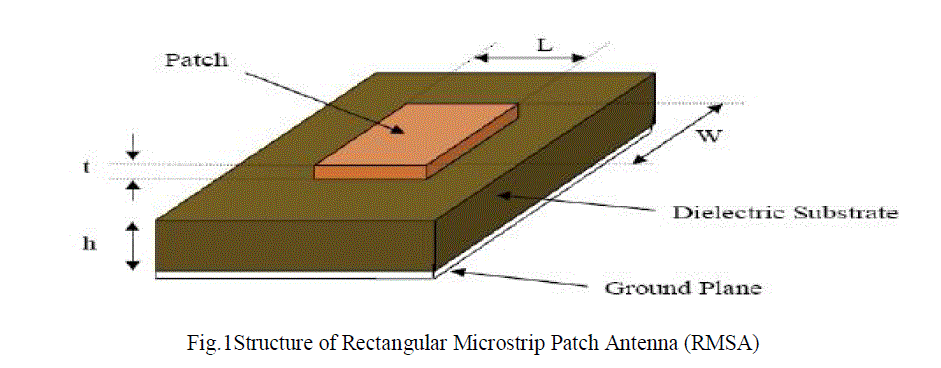 |
| Microstrip patch antennas radiate primarily because of the fringing fields between the patch edge and the ground plane. For good antenna performance, a thick dielectric substrate having a low dielectric constant is desirable since this provides better efficiency, larger bandwidth and better radiation. However, such a configuration leads to a larger antenna size. In order to design a compact Microstrip patch antenna, substrates with higher dielectric constants must be used which are less efficient and result in narrower bandwidth. Hence a trade-off must be realized between the antenna dimensions and antenna performance [3]. In this paper we simulate a RMSA working at a frequency of 2.34 GHz, the coaxial feeding technique is used as a feed for antenna, & simulation is done by using Finite element based HFSS software. |
II. RELATED WORK |
| In [4] a microstrip patch antenna is designed for a wireless communication application, which is operating at a frequency of 2.4 GHz. In this paper a RMSA is designed having substrate material as Styrofoam (εr=1.03) & height of substrate is 12 mm. An outdoor gain of 11 dB is obtained by using this design. A probe feed RMSA design is presented in [5]; this antenna is working at a frequency of 2.21 GHz & 4.45 GHz. The substrate material is RT Duroid (εr=2.2) & height of substrate is 1.6 mm. Another RMSA with same substrate material is present in [6] here height of substrate is 3.2 mm & antenna is working at a frequency of 2.36 GHz. A RMSA for operate in S band is deigned in [7], here the substrate material is FR4 (εr=4.4) & height of substrate is 1.6 mm. This design is working at a frequency of 2.25 GHz. A stripline fed RMSA is present in [8], which is working at a frequency of 2.4 GHz. Different Technique used for enhancement of bandwidth of RMSA are present in [9] [10]. |
III. GEOMETRY OF ANTENNA |
| The Geometry of H shaped microstrip patch antenna is as shown in Fig.2. The dimension of substrate is 66.7 mm * 53.8 mm, the thickness of substrate is 1.6 mm. The material used for substrate is FR4 having dielectric constant 4.4 & loss tangent of 0.02. The patch is rectangular shape; the total size of patch is 38.04 mm * 29.44 mm. The antenna uses coaxial feeding technique. The position of feed point is obtained by using trail & error based method. |
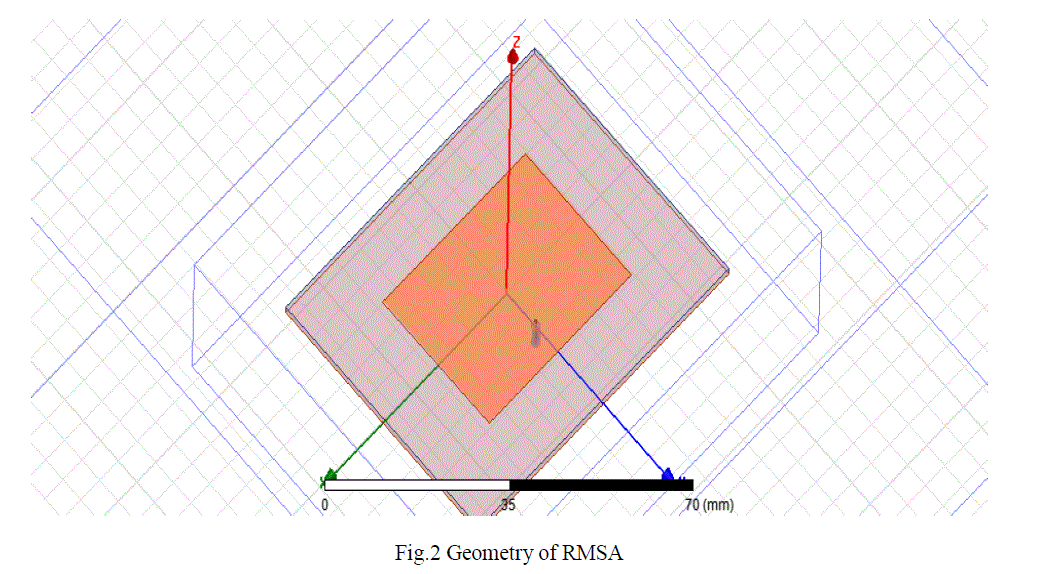 |
IV. SIMULATION RESULTS |
| The simulation of above design is being done using HFSS software. The substrate used here is FR4 having dielectric constant 4.4. The above given dimensions are used to simulate the structure. The operating frequency of this design is 2.34 GHz and the obtained return loss is -24.15 dB. The gain obtained at this frequency is 3.92 dB. Fig.3, indicate a plot of reflection coefficient (S11) vs frequency, which indicate that, antenna is start working at a frequency of 2.31 GHz (marker m1) & stop working at a frequency of 2.38 GHz (marker m3). The center frequency of antenna is at 2.34 GHz (marker m2). The bandwidth of antenna is 67 MHz. |
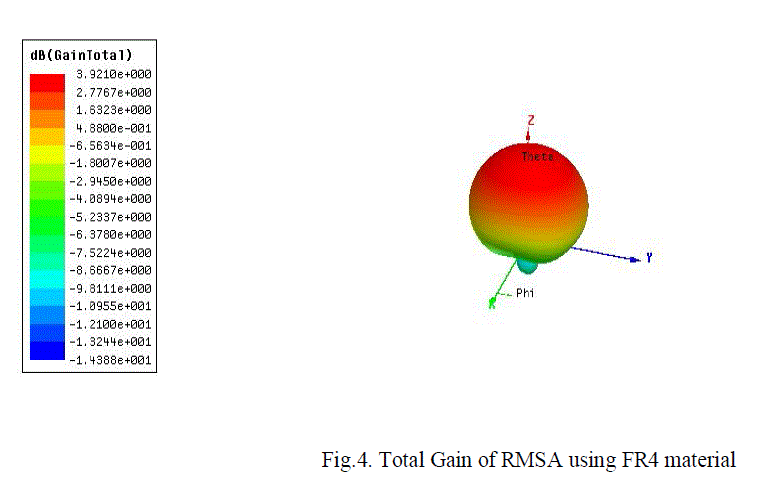 |
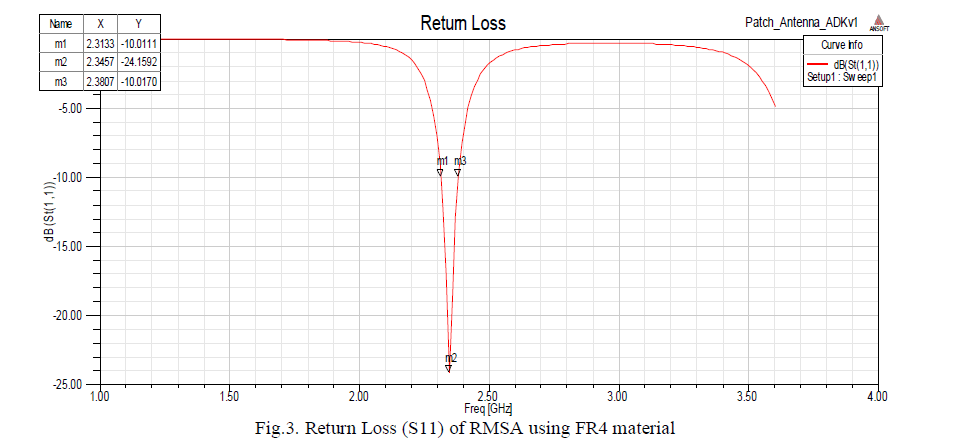 |
| The gain of antenna is increasing when we go away from antenna. A 2D radiation pattern of antenna, which indicates a unidirectional radiation pattern, having a major lobe & back lobe is shown in Fig.5. The maximum value of gain is 3.92 dB, at angle (θ) of 0 degree, indicated by marker m1. |
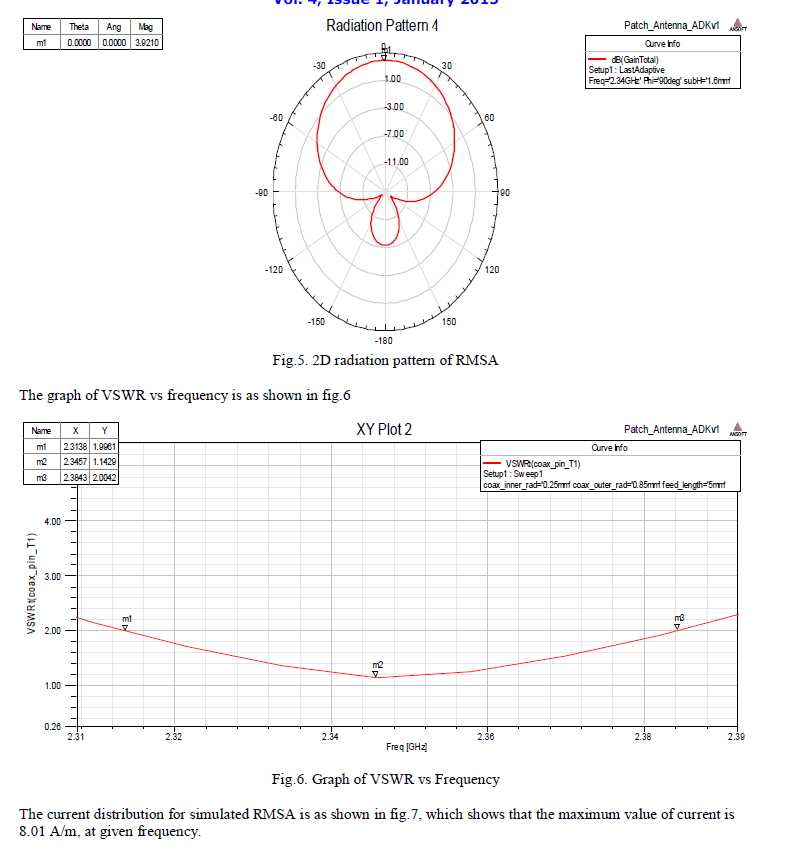 |
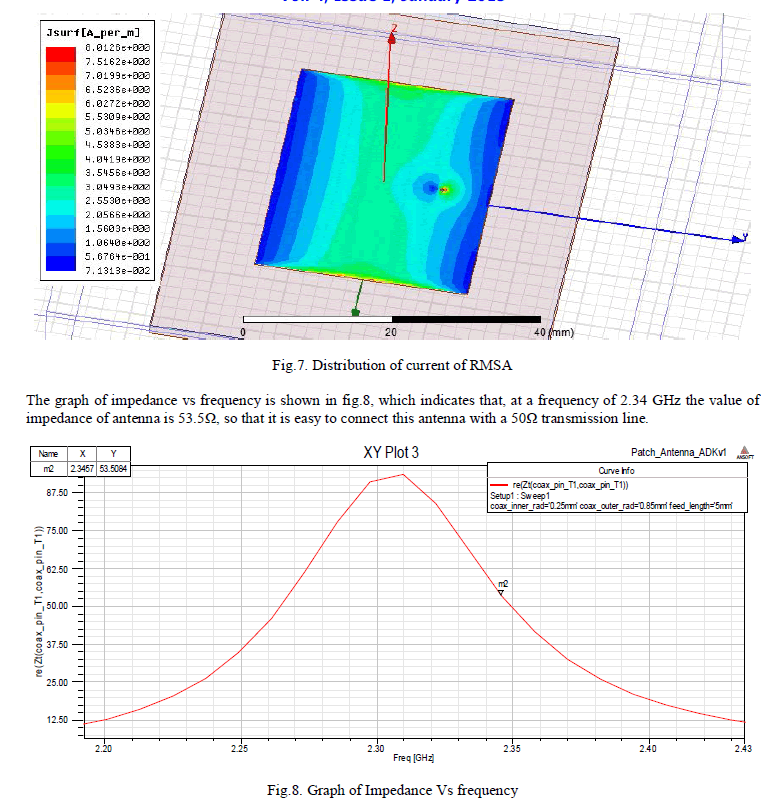 |
V. CONCLUSION |
| In this paper a rectangular microstrip patch antenna is being proposed & designed using HFSS software. It is being observed that the antenna is start working at a frequency of 2.31GHz, & stop radiating at a frequency of 2.38 GHz. The bandwidth of antenna is 67MHz, & total Gain obtained at this frequency is 3.92 dB. The antenna having impedance of 53.5Ω, due to this it is easy to connect a 50Ω transmission line to antenna, without generating impedance mismatch losses. |
References |
|